As the gardens and orchard were both newly installed this year, that part of the property has been host to numerous insect species since spring, some good, some bad, and a few ugly in recent months. As we produce everything organically, we don’t spray here, beyond the occasional angst-ridden jet of water targeted toward hoards of aphids swarming on the sorrel in the early mornings, and some days it seems we’re farming more aphids and leaf-hoppers, than food. That said however, we realize that it will take time to bring balance to the gardens here, and although the pests seem to be winning, for the moment, the beneficial insects are beginning to establish a notable presence here, including this Agapostemon texanus.
This female Agapostemon is the first sweat bee I’ve spied here. For as small as they are, they’re quite dazzling when the sunlight catches their iridescent beetle-green colors. Agapostemon bees are native to North America, with approximately 5 species being native to the Pacific Northwest, of which A. texanus is one.
Agapostemon texanus, is in the family Halictidae. The bees within the Agapostemon genus are commonly called ‘Sweat Bees’ because they’re attracted to human sweat, and savor it for its sodium content.
Now that we know they’re attracted to human perspiration, perhaps I didn’t find this female. It seems she most likely found me!
Before we encountered each other, I’d just spent a few hours weeding on the sunny, exposed slopes in the orchard, I admit to being almost completely melted into a puddle. When I first encountered her, I wasn’t sure if she was irritated with me. The honeybees mostly go about their business, and didn’t seem to mind my lens pushed up into the Verbena, but this little green Sweat Bee seemed to relish getting right in my face, as if I was invading her personal space, but it turns out these are actually very docile bees. I just happened to be somewhat irresistable that afternoon!
In addition to soggy humans, bees in the genus Agapostemon are floral generalists, dining on a wide selection of flower species. At the moment, with little in bloom here, we’re seeing them on both Verbena lasiostachys, and some heirloom Italian White, and Lemon Queen sunflowers planted along the edge of the vegetable gardens, and for now, this seems to be where most of our Sweat Bees are lurking.
This snappy fellow was playing hide-and-seek amidst the Italian White sunflowers.
Relative to the honeybees, they seem quite frenetic, zipping about rather unpredictably between the flowers, which makes photographing them truly challenging!
As you can see, Agapostemon texanus are robust, strikingly colored metallic green bees. However, these bees are significantly smaller than your average European honey bee, medium sized, ranging from 0.3 to 0.6 inches long. Females are completely green, like the one below.
Whereas the males have a bright metallic green head and thorax, but a striped, almost wasp-like abdomen.
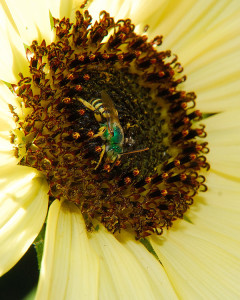
Male Agapostemon texanus. Note the Male's abdomen is yellow and black striped, compared to the female that is all green
Females carry pollen on brushes of hair, called scopa, on their hind legs. Apparently the female Sweat Bees are relatively fast-flying, and males supposedly fly more slowly, primarily because they are searching the flowers for females. With my camera in tow though, this male was much more difficult to capture than the female. Probably just the photographer’s curse.
Most Agapostemon are solitary ground-nesting bees. Two to 24 females will share a single nest, but each individual will build, and provision, its own nest cells. Agapostemon nest in deep vertical burrows, or soil banks. We had planned a retaining wall along the length of the road-cut leading to the gardens. However, last year, in the winter months, we noted a number of Coast Newts lurking in small burrows in this bank along the road-cut, and apparently the bees need this type of exposed vertical area for nesting too.
As there are no structures of concern downhill, like sheds, or the house, we’ve chosen to plant this bank with some native perennials instead, to help curb erosion, and the low retaining wall will now only be placed behind our (as yet unbuilt, not to mention, a year behind schedule) shed out in the vegetable gardens.
Although we’ve enjoyed seeing these bees, we want to encourage more native pollinators to visit Curbstone Valley. We recently received our native wildflower seed order, and now have a wide collection of both annual and perennial native blooms to plant this fall for the benefit of these critical insects. Thanks to Town Mouse and Country Mouse, who reminded us this past weekend that a local native nursery was having a blowout fall plant sale, we stocked up on some bee-friendly species that weren’t already in our seed order, and with a local CNPS plant sale coming up in October, we’re expecting the bees will be far better taken care of than the rest of us, come spring!

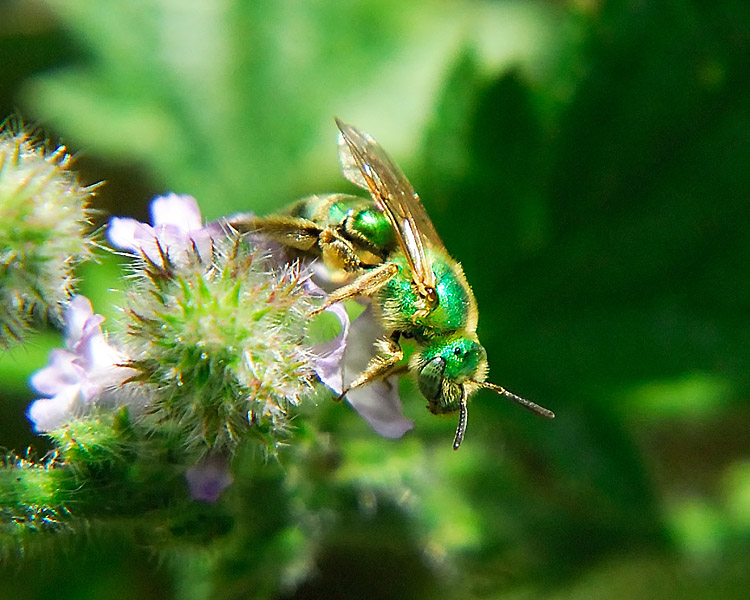
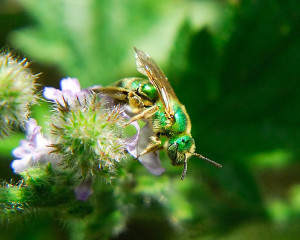

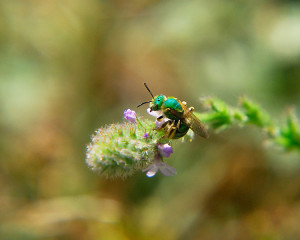
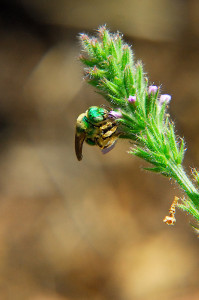
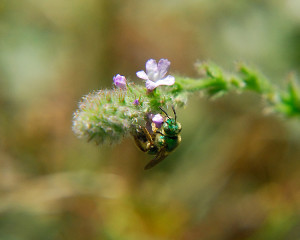

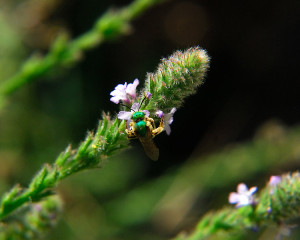
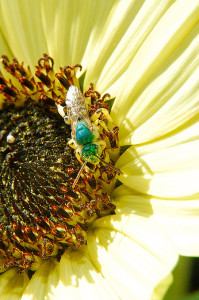
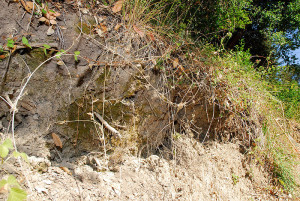
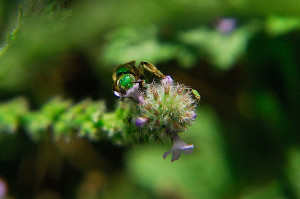







Clare, these pictures are terrific!! You did a great job, encroaching on their space, 🙂 to get great close ups. I’ve never seen this bee, it’s quite pretty.
Clare, This is a great post… I learned so much about this beautiful bee. Your photos are stunning and I enjoyed blowing them up to see just how amazing they are! Bravo! ;>)
I do love the sweat bees! We get them in droves on the firebushes and spiderworts and gaillardias and roses and well…like you said, they are generalists. These are beautiful pictures you have taken. I do find bees very hard to photograph, so I rarely have such photos to publish (of course, it is the camera’s fault).
What great photography and information! I must admit that I have not seen an Agapostemon bee…or at least not close enough to notice the beautiful metallic color.
Love, love, love these photographs!
Ooh, what great pictures and I can vouch that they are hard to capture on film…cute lil critters though huh?
Love it! We don’t have ultra green sweat bees (though I wish we did). How ever did you get them to sit through a photography session? My carders and leafcutters are faster than my shutter. The masons, at least in the morning, have stood still long enough for a a mug shot 🙂
That’s just it, they DON’T sit still! I’m stubborn though. Actually, the females were easier to photograph, as they seemed mesmerized by the Verbena. The male, although he hung out around the sunflowers, was bouncing around like a caffeinated ping-pong ball! Thankfully, if I hold the shutter release down on my DSLR, it fires off about 10 shots at once. What you didn’t see were all the bad photos! I’m with you, I’d rather shoot Mason Bees, or bumbles! 😛
Those are awesome photos!!! The closest I’ve ever come to a newt is a Harry Potter book so I’m a bit jealous! :0)
Great shots! I have not seen green bees before. How do you know the name? I have snapped photos of various types of green insects lately and have yet to identify them.
Depending where you live, there are a number of online bee identification tools and keys. There may also be some publications and books available to help with identifying native pollinators in your area. Most are regionally specific though. You’re off to the right start, having a good photo is very important for identification. Something as simple as leg color, or antennae color can be the only difference between related species.
That first photo of the male swat bee in the center of the flower is like artwork! You always have such interesting, educational posts. What a fun way to learn!
Very cool photos! That reminds me I have to work on getting a little more exposed dirt in the garden, and maybe I’ll move the bee house as well. And next spring, I’ll sow the Madia seeds so I have more summer food for the bees.
Of course, who know what crazy ideas we’ll get at the wildlife gardening class this weekend at Tilden (there’s still room, I think ;->).
We seem to have a lot of native Madia here, and at times it was the predominant flower in bloom. The bees to seem to like it.
I can’t make the class this weekend, but I hope it’s fun! Let me know if you acquire any interesting pearls of wisdom.
Neat little bees. It’s nice to more about them.
I really like your blog and what you’re doing with your farm. My husband and I have long been discussing doing something like this and I’d really like to know more about it. Were you always a farming family? How did you get started?
I haven’t gone back and read your archives yet but I will be.
I don’t think either of our families have farmed much in the last 80 years to be honest. I did have an uncle that raised chickens on a commercial scale in England when I was young, he had a few pigs too, and an aunt with horses, but both of us grew up more city slickers than barn bods. I’ve always been outdoorsy though, and gardened for as long as I can remember. My grandfather did grow a lot of his own vegetables, and perhaps for me some of this started there.
We moved from a 6,500 sq ft lot, to 7.5 acres here, entirely too large to make it all a formal garden like our last ones. Then one day we saw the baby chicks for sale…and, well…it’s been a slippery slope ever since! The desire to garden with natives was borne out of recognition of the invasive plants on this property, and all the wildlife here. It just made sense to try to restore some balance with the flora for the benefit of the farm’s wild inhabitants, but it’s definitely a learning process, and a challenge, but never ever dull! 😀
Great photos. I know some of the males of native bees will “guard” certain choice flowers so when the females come around they’ll be first in line. I can’t remember if sweat bees do this. Did you notice the males hanging around certain groups of flowers?
Actually, so far I’ve only noticed the males on the sunflowers. We haven’t planted them here before. Although I must admit, these bees are so small that unless I’m really looking for them I tend not to notice them.
You know Clare I think I am a flower generalist, too. I love them all!
They’ve been busy in the garden here~The love agastache and occasionally I’ve managed to capture them on an aster. They are beauties for sure! gail
Dear Clare, As you say, getting an environmental balance will no doubt take time, but it is so good that you are making such strenuous efforts to achieve this balance with Nature on your most beautiful farm. One day, harmony will reign and the journey to achieve it is certainly most interesting for me as well, I am sure, for your other readers.
The photographs of the bee are absolutely wonderful. What a startling colour its body is!
They really an eye catching color. If they weren’t, I think I’d have missed them entirely!
Those are awfully pretty beneficial little bees. We have lots of bumble bees here, but I’ve not seen the sweat bees in my garden. Perhaps the gnats have one the rights to the sweat – we have an abundance of those! It is always fun to learn about insects, especially with such great illustrating photos.
Oh I’m so glad you found them! Perhaps I’m a bit too obsessed about bees, but it was the highlight of my month to see one in person! Too bad they’re temperamental super models, though. Very hard to get a good shot! (Although you managed to get a ton!)
Hello Clare,
Thanks for sharing your wonderful photos and knowledge of these wonderful little bees! I’m becoming more and more interested in pollinators the more time I spend in the garden and it’s wonderful to learn about them from all over the world. These are quite beautiful in their metallic green…now I just need to find something that might find me attractive after a sweaty day in the garden!